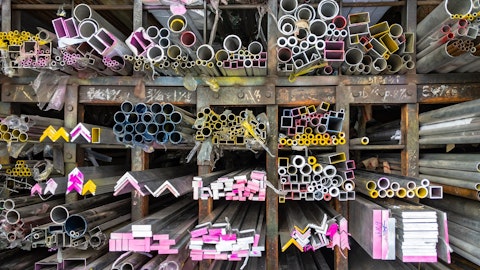Vince Morales: Yes, Jeff, on the balance sheet questions, I’m not going to be able to calculate the FIFO, LIFO impact on the fly here. We can just a reminder everybody, we’re at 75% or so FIFO, the difference between, again, the invoice cost and what we’re realizing on the income statement for raw material moderation that is tens of millions of dollars, if we move that to a FIFO. I can’t calculate it precisely. As it relates to payables, for us, we had a couple of items in the fourth quarter. Our tax provisioning is about $100 million higher. We ended the year on a weekend, two-day weekend. So our accounts payable is higher because of that. There’s natural FX in that number on a year-over-year basis. And we had, as you saw, an environmental special for about $30 million where we accrued $30 million for future environmental spending.
And we talked about the compensation increase in the fourth quarter. So, those are the big elements in our payables on a year-over-year basis.
Operator: Our next question comes from Vincent Andrews with Morgan Stanley. Your line is open. Please go ahead.
Vincent Andrews: Thank you. A few quick ones from me. In the first quarter, I get the timing shift of Easter, but February also had an extra day this year. So does that not offset the Easter impact and then also on TiO2, how much Chinese TiO2 are you guys buying these days? And how much of it is in Europe? And have you changed any purchasing patterns as a function of the EU’s investigation to Chinese imports? And then lastly, the Pro architectural business has been holding up an awful lot better than the DIY, just in a similar fortunately, far enough away from COVID now that I think we should be able to have a conversation about what’s driving the DIY weakness other than just a pull forward of volumes. And what’s keeping the Pro business so high or so strong because it just seems like there’s a disconnect between sort of pro demand being there, but DIY being so weak. So if you could help with those three things, I’d appreciate it.
TimKnavish: Okay, Vincent, this is Tim. On the Q1, yes, I’d say correct. There is an extra day in February. I think the negativity of Easter impacts that more significantly in 1 day because particularly some parts of the world, Europe, vacations before, some vacations after other parts of the world. We do have Easter time is typically a good month for us in Mexico. And so it’s more significant than the one day. But you are correct. Also on Q1 though, we have in addition to the Easter impact, you do have that customer load-in that we mentioned and the energy pricing issue that Vince mentioned earlier. On the pro DIY, first of all, DIY remains down? And yes, some of it, I don’t know if we could put a time stamp exactly on it, but some of it, you could call it COVID — post-COVID hangover, as people did a lot of pull forward, I think now it’s more general inflation, and general consumer spending and confidence on remodeling at home.
And some of it is existing home resale too. Where sellers — DIY sellers will paint their house, DIY buyers will paint their house. So I do think some of it is related to what’s happening with existing home sales as well. But I do think it’s some combination of that and just overall inflation and how it’s hitting the average consumer’s pocket book and the decisions that they’re having to, make. On the Pro side, does remain strong. We do see some areas of weakness, again, in things like existing home resale, some of that’s done by Pros as well. But we see strength in commercial strength and maintenance. And I think that’s why it’s holding up well. And that’s not only a U.S. phenomenon, that’s a phenomena that we see in Europe as well.
Vincent Andrews: TiO2?
TimKnavish: TiO2 Europe, I’m sorry, I missed that element. Yes, the TiO2 Europe, we’re watching this process very closely. A couple of things, we have not dramatically shifted. We do buy a good bit from the Chinese TiO2 suppliers. They’re an important part of our supply portfolio. And we’re watching this process in Europe. We think, number one it will be a very lengthy process. Number two, we have — we’re constantly working on the diversity of our supply base in TiO2 and the flexibility of that supply base. And we’ve made significant improvements there and where else we can use the various TiO2 from different parts of the world, including China. And again, we continue our longer-term initiative of reducing our dependence solely on TiO2 by removing it from our formulations without sacrificing performance.
So those three things I would point to. Again, we’re watching it very closely. And we’ll adapt. And I’m confident that the between the upstream supply being in a long situation. And the diversification work that we’ve done, we’ll do what we need to run our business.





